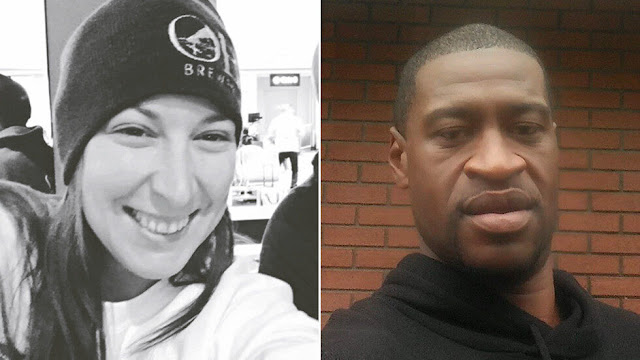A tale of two police shootings – an example of blatant media bias
It seems that with each passing week, the US mass media reveal their
biases in evermore blatant and flagrant ways.
Every story reported is politicised to within an inch of sheer fiction, spun
and interpreted artfully by an oleaginous industry to bodyguard their preferred
political faction. And every story that disproves the leftist’s grand narrative
is tucked away in some unobtrusive paragraph or ignored altogether.
To illustrate this media prejudice, let us compare two deaths at the
hands of the US police, that of George Floyd and Ashlii Babbitt.
George Floyd’s death sparked months of protests, interspersed liberally
with riots and looting, across multiple cities, causing billions of
dollars of damage and more than 20 deaths. The immediate a priori assumption is that his death is
the result of systematic racism deeply embedded within the US police force.
This is despite the fact that the Minneapolis Chief of Police, Chief Medaria Arradondo, is a black man. And as I have written previously, this is against the evidence of multiple scientific studies on racial disparities in deaths by police shootings.
The trial of Derek Chauvin, the ex-police officer involved in Floyd’s
death, has thrown up many points of contention that flies in the face of the
assumption that Chauvin deliberately murdered Floyd.
For example, Floyd’s toxicology
report showed that the concentration of fentanyl in his system at the time of
death was more than three times the
potential lethal concentration; a drug that is known to cause asphyxia, the official cause of Floyd’s death. Indeed, from the available footage, Floyd complained of having trouble breathing while
he was in the police car, before he was taken out and placed on the ground. Furthermore,
the autopsy “revealed no
physical findings that support a diagnosis of traumatic asphyxia or
strangulation.” Indeed, footage from one of the officer’s bodycam showed that
at least for some of the time, Chauvin’s knee was not on Floyd’s neck, but
rather appear to be on his upper shoulder. The technique Chauvin used was also very
similar to what is shown on
Minneapolis Police Department training material.
This does not mean that Chauvin’s
actions may not have contributed to Floyd’s death. For example, while Floyd was
on the ground, Officer Lane said to Chauvin “Should we roll him on his back?”,
and Chauvin replied “No, he’s staying put where we got him.” Lane replied
“Okay. I just worry about the excited delirium or whatever.” And Chauvin
replied “That’s why we got the ambulance coming.”
One might argue that Chauvin
made the wrong decision. But he may have thought Floyd was lying about not
being able to breathe, as Floyd talked nonstop when he was first placed on the
ground. Chauvin even told Floyd: “Then stop talking, stop yelling, it takes a
heck of a lot of oxygen to talk.” In addition to the fentanyl, Chauvin could not
know that the relatively young and fit-looking Floyd had a 75% blockage to his
left coronary artery (“Arteriosclerotic heart disease, multifocal, severe”,
according to the autopsy report), which may also have contributed to his death.
One should remember that
the legal system works with a presumption of innocence and the notion of
reasonable doubt. The evidence presents plenty of doubt for the second-degree
and third-degree murder charges levelled against Chauvin.
Despite this, and before the evidence was even presented or examined,
the presumption of guilt of the lowest motive was flagrantly paraded on the
media streams. You will have to, like I did, dig very deep to find a headline about
the trial that did not propagate the notion that Chauvin is a vicious murderer.
The atmosphere has been prepared like a pressure cooker.
Like a vulture, Maxine Waters, the Democratic senator who has a history of
inciting political violence and harassment, once again used language
akin to a despot, suggesting at a protest in Minnesota (breaking curfew rules) that
they “were looking for a guilty verdict” and that should the court decide
otherwise, activists have “got to stay on the street” and “get more
confrontational”. She is essentially threatening the ongoing legal procedure
with violence to get an outcome that they desire. The judge for the case
rightly slammed her
actions, as has many Republicans. Yet the
Democrats and the media defend her. The Guardian, for example, pirouetted
that “The Democratic representative Maxine Waters has come under criticism from
the Republican house minority leader, after she expressed support for
protesters against police brutality”. It’s a sentence that will make a real
estate agent wince.
Now, compare this ultra-high profile death involving the police to another that went under the radar. The unnamed police officer at the Capitol riots who shot and killed an armed woman, Ashli Babbitt, in an action that one might argue to be extremely reckless (the officer shot into a crowd, with other police officers standing behind Babbitt), and in circumstances much more clear than that of Floyd’s death, will not even face any charges.
Both Floyd and Babbitt were conducting felonies, but whereas one death led to almost a year of riots, and threats of more to come unless the police officers involved are given the harshest of sentences, the other death has sunk to obscurity, with her shooter given not even a slap on the wrist. In the era of feminism and anti-police rhetoric, why did the killing of a young, unarmed female veteran receive so little attention, especially from the left? Because she belongs to the wrong political tribe. For the media, politics trumps all the slogans.
Augustine of Hippo is supposed to have said that “the truth is like a lion; you don’t have to defend it. Just let it loose, and it will defend itself.” But the media is poised to act like a dungeon, ensuring that the lion has no chance of freedom.






Comments
Post a Comment